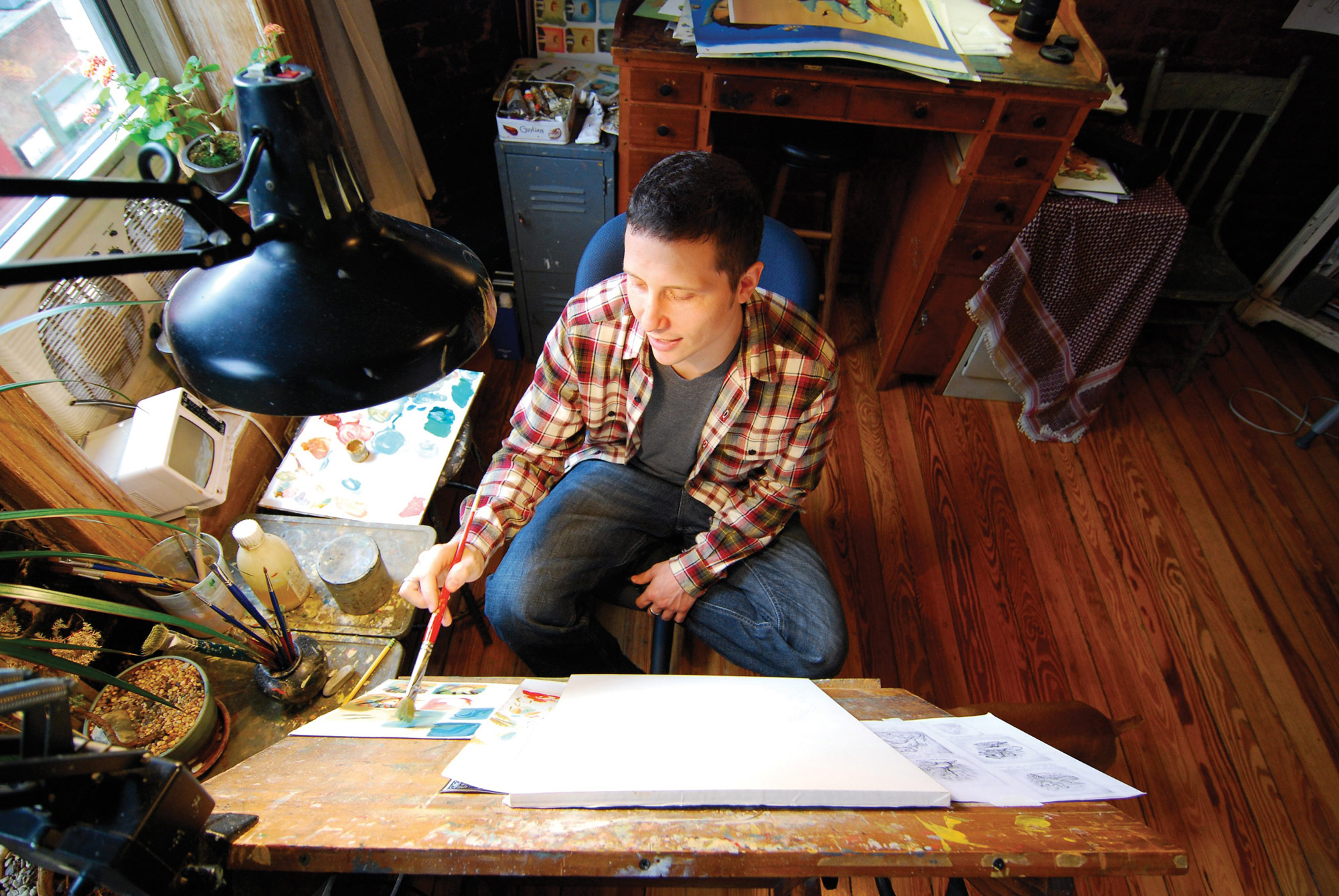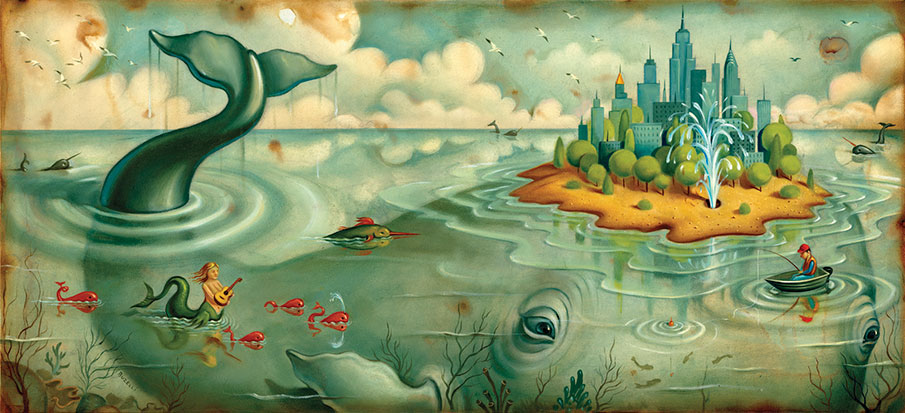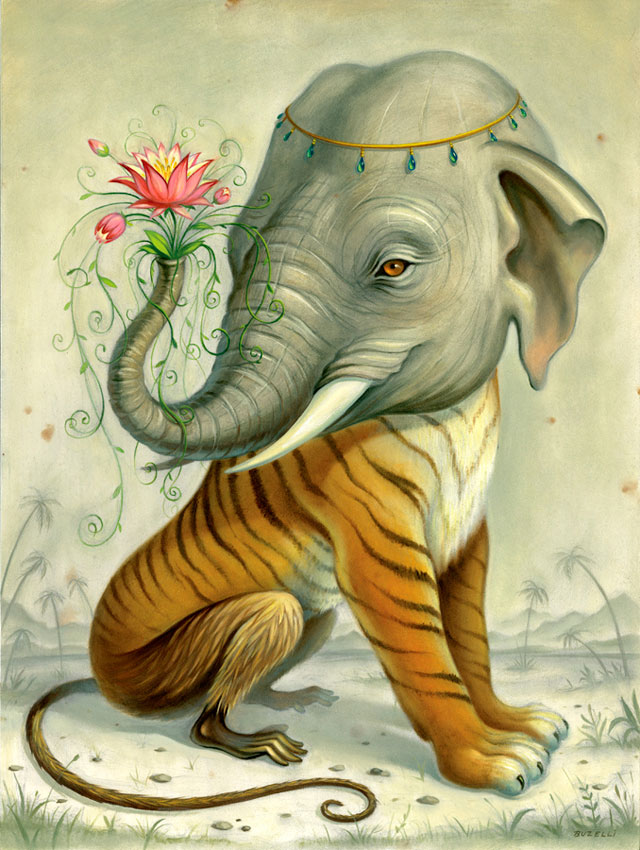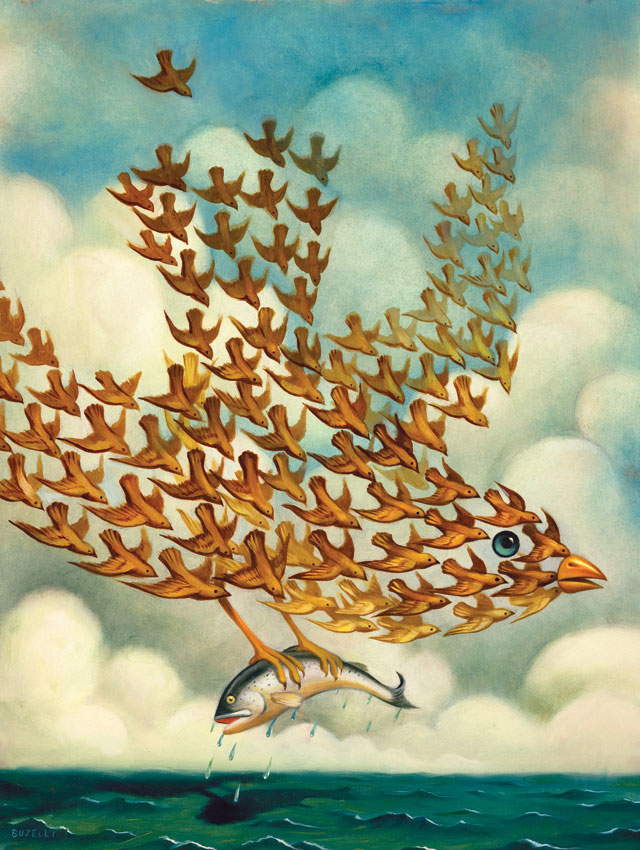
- Interview by Tina Essmaker April 3, 2012
Chris Buzelli
- artist
- illustrator
Born in Chicago, Chris Buzelli was influenced by painting side by side with his grandfather, Armondo Buzelli. After graduating from Rhode Island School of Design, Chris moved to New York City. His oil paintings have appeared in many publications, books, and projects for design and ad agencies, and he shows in various galleries throughout the US. Chris teaches at RISD and SVA and lives in New York with his wife, SooJin.
Interview
Describe your path to becoming an illustrator.
Oh boy! I’m trying to figure out how far back I should go. I think it’s the average story at first. Growing up, I was good at drawing and I took a few art classes, but I didn’t really know what illustration was until high school when my art teacher took me in and introduced me to it. He was a great teacher; he created a whole separate room for me and he also created all these classes for me. Instead of taking one art class my senior year, I had three.
My teacher also introduced me to Paul Cadmus—a really neat artist and illustrator from the 1930’s and 40’s. His work looks contemporary and it was actually banned for a period of time. He did this series called “The Seven Deadly Sins” and that was the first time that I saw something in art that I was interested in—it wasn’t the same historical stuff that you see in art history books. I thought, “I really want to do something like that.”
From there, I got into Rhode Island School of Design (RISD) and had some great teachers like David Macaulay, Barry Moser, Russell Jones, Lenny Long, and many others. That’s how it began. Then, after I graduated from college, I came straight to New York City because it was my dream.
You went right from high school to RISD. Was that something you knew you wanted to do—was it your dream school?
I was told that RISD was the dream school. I had been offered scholarships at Pratt and the University of Chicago and I think that when I started visiting all the schools, I realized I wanted to go to RISD. I remember staying at Pratt for the weekend and one night there were gun shots. I thought, “This isn’t what I want.” I had grown up in Chicago Heights and had already came from an urban, stressful situation and I didn’t want to do that again. Then I went to the RISD campus and I don’t know if you’ve ever been to Providence, but it’s a really small city—a quaint college town on a hill. I was hooked.
I remember visiting the campus on a Sunday morning and I toured the architecture department and everyone was up and in the studios working. I thought, “This is where I want to go.” I later learned that that only happened in the architectural studio. (laughing)
I graduated from RISD thinking I was going to make it right away. I soon found out that it wasn’t that easy. Reality set in and I had to get a part-time job. When I graduated, one of my teachers told me that it would take a good 7–10 years because my portfolio was a little darker and esoteric and not very business oriented. I graduated in 1995 and my portfolio included a series of images based on the Weekly World News, which is that tabloid newspaper full of outlandish stories. My portfolio was filled with stuff like that and in 1995 that was not the norm, so it did take me a while.
I also think it took me a while because I was a good student and a decent artist, but I just wasn’t a very good illustrator yet. There’s a difference.
You moved straight to New York after graduating from RISD. Did you know anybody?
I moved in with a friend from college. We were roommates for almost a year. I didn’t really know anyone, but NY is a great place; you can literally step outside your door and walk to any number of publishers.
You’re freelancing full-time right now. How long did it take you to get to that?
I was getting jobs here and there for the first few years, but it really did take about seven years before it became a full-time job. I’ve been freelancing full-time for almost 10 years.
You touched on this, but was creativity a part of your childhood?
(laughing) I was always trying to show off with drawing. I loved impressing people—that was my big thing.
This is the story I tell during lectures when I teach. Being an artist started very, very early for me. My parents got divorced when I was maybe five and my dad got custody of my sister and me on the weekends. He didn’t know what to do with us, so he would drop us off at our grandparent’s house. They owned an apartment and television repair shop in the middle of South Chicago Heights. So, I grew up with my grandparents on the weekends and we pretty much stayed inside because it wasn’t a place where you wanted to spend time outside.
I would go into the shop every Saturday morning—there were hundreds of TVs—and I would turn them all on to my favorite cartoon. On Sundays, we started watching Bill Alexander, who was Bob Ross’ teacher. He had this crazy accent and it was all about the “magic paintbrush”. We watched Bill’s show every Sunday and I remember feeling so relaxed and calm. I even remember falling asleep on Grandpa’s shoulder while watching it.
A couple years after that, when I was maybe seven or eight, I walked into the repair shop and my grandpa had bought the Bill Alexander “Magic Paintbrush Set”. It came with a whole kit and he had set up two easels. Every weekend we watched Bill Alexander and then painted together. I have hundreds of these oil paintings; I started oil painting when I was very young.
Whatever happened to all those paintings?
My grandpa retired when I was in college and he had been collecting all of my work from grade school and high school; he had piles and piles of it. He had emptied out the whole shop of televisions and hung my artwork up—it filled the whole space. He created this Chris Buzelli museum (chuckling) and he lovingly wrapped all the paintings in saran wrap and scotch tape to protect them; I’m sure it wasn’t archival, but it was really sweet. He would even have some local people come in for viewings. It was in a really bad part of town, so I’m amazed he let people in.
When I was in college, he used to constantly call me on the phone and he would ask if I had any new work. I would tell him, “Of course I have new work.” He would reply, “Well, I need it here because I need the whole collection. It’s not complete without everything.”
He was a really special guy. I think that if he had had a chance and if it was more acceptable, he would have been an artist. His family came from Italy when he was really young and they were very poor. He was really creative and was constantly drawing. He’s the real artist.
That’s so cool. You started painting when you were really young. Did you have an “aha” moment along the way when you knew you wanted to make a living doing illustration?
My goal was always to be an illustrator. It was make it or break it. I was really narrowly focused and luckily, I made it—I guess. Somedays I feel like I haven’t made it.
Honestly, I didn’t have an “aha” moment until about seven years after I graduated. I see this happening with my students—every once in a while, you see a light switch go off and instead of feeling like they have to do illustration, they want to do it. It’s a rarity for that to happen in college. Luckily, that eventually happened for me. For the first seven years after I graduated, I had the mindset of, “I have to do this; I have to make a living out of this; I have to please the Art Director.”
Here’s another story—take it for what it is. I was playing basketball with some friends who play basketball just as well as I do, which is not well at all. I collided with a friend, my knee bent backwards, and I tore all the ligaments in my knee. I had surgery and then I was stuck in my apartment, which is a fifth floor walk-up. I’m a big baby when it comes to pain, so I was given painkillers.
At the time, I had been doing some collage/painting type work; I was very heavily influenced by Henrik Drescher and I think I thought that’s what illustration was. Anyhow, I don’t know if it was because I was stuck in my apartment and going stir-crazy or because the painkillers gave me a little courage, but I called my rep up and told him, “I’m not doing this collage stuff anymore. I’m tired of it. It doesn’t feel right for me.”
He said to me, “Come on, Chris, this is just a business.”
I said, “This is not only my business; this is my life’s work.” I was so righteous.
Just like that, I made this change where, within those next two weeks, I created a whole new body of work. I got back to what I really enjoyed doing, which was making a really strong drawing and using vehicles that I’m interested in. Before that, I was doing a lot of corporate work and trying to please the art director. I forgot that it’s also about figuring out how to spark that certain something within yourself as well as pleasing the art director. From that point on, it snowballed and it was amazing to see—just like that, I started getting all these new clients. It wasn’t just the corporate stuff; it was music gigs and advertising work as well. It was a huge “aha” moment for me.
Was there a point in your life when you decided you had to take big risk to move forward? Would it be either of the things you already mentioned—moving to New York or the call with your rep?
Calling my rep was definitely a risk, but it was something that I had to do.
I’m trying to think of risks. I’ve been very fortunate. You saw SooJin, my wife who came in here and said hello. She’s an art director and I started working with her early in her career at Asset International. When I first started working with her, the company was new, she was new, and I was new. I learned a lot and made a bunch of mistakes; I did some horrible, awful illustrations. If I did that now, my clients wouldn’t hire me back. Luckily, I got to make mistakes and grow through my time there.
It’s unfortunate that there aren’t too many places where you can do that anymore. It seems that you get one shot and that’s it. There aren’t many art directors who have the time or position to nurture an illustrator through the beginning. That’s unfortunate because it took me years and years until I could make a strong illustration. I see a lot of students graduating now and the ones who make it are the ones who are really good right out of the gate. I see other students who have the desire, but their knowledge and skills just aren’t up to the professional level yet. But happily, I’ve seen a lot of my students do alright. Not all of them are illustrators, but a lot of them stay in the art field and they’re making it.
I definitely take risks in my work. I’m still making mistakes—I just don’t show them. They usually end up in the garbage.
Did you have any mentors along the way?
I’m trying to think. I was a shy kid, even throughout high school and college. I felt like I had to do this on my own, but I definitely called up a few people who were really making it in the field of illustration. They weren’t exactly mentors, but they helped me along the way. I remember calling Jordin Isip up out of the blue and he was so, so gracious and very nice. I think he even gave me his mailing list. It was a big help. James Yang was another one of those guys.
When I graduated, I even tried to get a job at the Society of Illustrators. (laughing) They told me they didn’t have anything. I told them I’d take anything and that I just needed a little bit of money for rent. For about two or three months, I varnished all the wooden wallboards up in the bar area. It was like my “wax on, wax off” moment. Now, when I’m up there chatting and drinking a beer, I can tell people that I varnished all of this. (laughing)

“I began to make a concerted effort to create art that could not only work for a magazine or newspaper, but that could also work outside of that realm and stand on its own. Once I figured out how to do that, I think my work started to connect more with people.”
Are your family and friends supportive of what you do?
Yeah. My mom was a huge support and pushed me along the way. In high school, I tried to drop out of art classes because I wasn’t getting along with the teacher. She marched me back into the school and made me beg to get back into art.
I don’t think my family really understood it for a long time just like I didn’t. It was cute. About a couple of years ago, Urban Outfitters called and wanted to sell a few of my pieces as wall art. That, out of anything, got me the most amount of general publicity outside of the art world. I went home for the Holidays and relatives were coming up to me saying, “You’re famous. You’re in Urban Outfitters.” I think that was the first time they understood what I did—when it became a commodity to them.
My grandpa—I’m talking about him again. I remember when I was first applying to colleges and I applied to RISD and he said, “Who gave you this idea to go to art school?”
I replied, “Uh, you did!”
(all laughing)
Do you feel a responsibility to contribute to something bigger than yourself?
Boy, that’s a heavy question. Yeah, I do. I think that’s what happened during that time I busted my knee. I began to make a concerted effort to create art that could not only work for a magazine or newspaper, but that could also work outside of that realm and stand on its own. Once I figured out how to do that, I think my work started to connect more with people. I also began making the pieces more personal; sometimes it was as simple as painting my sister in a piece or hiding a secret about myself in it. Once I made it personal, it sparked something in me to make a stronger piece and I also saw it start to connect with another crowd—specifically galleries and collectors.
Tina: I don’t remember how I came across your work, but I really liked the piece, “Giant Obligation”. I looked through your portfolio and although most of the pieces were editorial and for a specific purpose, it was still work that resonated with me.
Thanks. Even though that piece was about giant obligations, I think I had read a passage from Moby-Dick and that became the ghost of Moby Dick for me. That was one of the things that was holding my interest and making me want to make that piece stronger—making it into my own personal playground or story. You can’t do that with every piece, but I really try. It’s one of those added puzzles that I put on top of the actual illustration job. I not only solve the puzzle for the concept, but I also try to make it personal and make it something that I want to work on.
It’s hard to do that sometimes, especially when you’re sending out three ideas for one piece. I learned early on that it’s best not to send a sketch I don’t want to do. More times than not, that will be the sketch that’s picked and then I’m stuck doing something I have no desire to do. For me, it was important to take a step back and really focus on the concept and sketch phase until I got it “right” and liked all three sketches.
Good advice. You also teach. Is that something you do as a means of giving back?
It didn’t start out as giving something back. At first, it was more about the challenge. I guess I was trying to impress people by going back to my school and teaching. It was for all the wrong reasons.
I had experience teaching part-time at a grade school in Manhattan for kids with learning disabilities and then, during college, I had done workshops with people who had disabilities. I really enjoyed both of those experiences, so when I was asked to teach at RISD it was like, sure! I think I was just very young and green when I started teaching. I tried to do my best, but I wasn’t an educator; I was an illustrator. There’s a big difference between the two and I’m still learning that after 10 years of teaching.
I remember that I wasn’t getting very good feedback from students early on because I was young and was very blunt and honest. There were comments like, “Who does this young punk from New York think he is?”
Were you making them cry, Chris?
It’s funny because they do cry now, but I’m really not a mean teacher. I think it’s all about the rumors passed on from other students, “Oh, Buzelli’s class—he’ll tear you apart.”
Well, Lotta had really good things to say about you.
She had great work. She was one of those students who I didn’t necessarily have to teach. She already had the tools to be a good illustrator. I just had to push and pull her to be confident in doing it. She’s one of those students whose work you don’t want to interfere with—you push them in other ways.
That’s one thing I really enjoy about teaching—finding something within each student and then pushing and pulling it out of them until a spark happens and that illustration starts clicking for them. I love doing that. I get a kick out of it, even though I’m not so sure my students get a kick out of it.
They’ll appreciate it later on. Since we’re talking about students and teaching, if you could give advice to an illustrator starting out, what would you say?
What do I say to them? Oh boy—so many words of wisdom. I’m like the Dr. Phil of art education. (laughing) I can only tell them what I’ve experienced, which you’ve already heard. It’s going to take a while, but if you really love it, you’ll figure out a way to do it.
It’s different for each person. I’ve been fortunate the past few years. I’ve had some superstar students who are well-rounded and I feel like I was sort of a piece to that puzzle of opening up the door to the illustration world. For me, it wasn’t about words, but about showing them how to get started and giving them that leg up. They seem to be doing alright. In the past few years I’ve had some really talented and hard working students. You saw Lotta’s stuff. Then you have people like JooHee Yoon, Victo Ngai, Wesley Allsbrook, Jing Wei, Dadu Shin, Robin Williams, and Charlie Immer—I could go on. These kids are all doing super well.
I’m only remembering this one piece of advice because one of my students quoted me recently, but it’s something to the effect of, “Style is overrated—it’s merely one’s habit of drawing based on personal experiences. Everyone has a unique style because everyone has a unique life.”
They’re always so worried about style. That’s when I tell them, “You basically already have your style—it’s those mistakes you’re making in your sketchbook; it’s those little doodles that you’re doing. Once you let that start to happen, that’s your style. Stop trying to look for it in something or someone else.”
Are you satisfied creatively?
I’m going to give you the typical artist answer because it is so true. You’re never really satisfied. You’re always looking to the next piece to get it right. However, I got to the point a few years ago where I was really unsatisfied and too negative. It began to affect my work. I had always thought that was a positive thing to not be satisfied, but that became dangerous for me. So, now I have to celebrate a little bit.
Each piece is a challenge for me. I hope I make it look easy and I hope the art directors think it’s easy for me. There’s the concept phase, the drawing phase, and then the painting phase, which is a serious battle. I’m back and forth thinking, “Oh, no! This is not looking good. Maybe I should start over? Oh, shit! No, keep working.” It’s not necessarily an enjoyable process. It’s something I love to do, but it’s not enjoyable until that last part when I see it coming together and think, “Yes! This is what I was doing all of this for.” I get my two seconds of satisfaction at the end of a painting. And then it all starts over again.
How does where you live impact your creativity?
I don’t think I would be where I am today unless I was living in New York City. It’s almost impossible to go out my door and not be inspired. Every week there’s something going on. There’s a show opening at a gallery or some illustrator friends are getting together at the bar. Even if you’re a hermit like me, it’s almost impossible to not get immersed and involved here.
I also love surrounding myself with people who are better than me, which is really easy to do in NY. A majority of the people who I look up to live in this area. It’s nice because you get to rub shoulders with them at functions.
The city is also just two hours away from the Catskills or hiking. I think that by depriving myself of nature and animals, it comes out in my work—I’m stuck in the concrete jungle all day long.
What does a typical day look like for you?
It is very typical. I have to set up a work regime. That’s the only way I make this work. Every day I get up and walk my wife to the subway at 6:30am because I’m scared she’s going to get mugged; I’ll probably be the one to get mugged. I walk the dog as well and then come back in, have my tea, check emails, and get right to work from about 7:30am until noon. That’s my prime time. I know that if I don’t get a majority of my work done in that time, it’s not going to happen. Around noon, I’ll take a quick break, walk the dog and go for a run. Then I get back to work until my wife comes home for dinner around 6pm.
There are those days where I start my second day after dinner because it’s crunch time and I have a project due or I have to produce 24 paintings in a month. Then I have to trick myself into having two days in one. That second day starts around 7pm and lasts until I get googly-eyed and know that I’ll fuck everything up if I keep working. No more all-nighters for me.
No all-nighters for us either—not anymore. Now for some fun questions. Do you listen to any music while you’re in the studio?
I listen to a lot of my friend’s band, A Place to Bury Strangers. It’s good, loud music. I also listen to my cousin’s band. They don’t have a name and they’ve since broken up, but it’s similar music.
Any favorite TV shows or movies?
Oh, boy! Breaking Bad is one of the best shows on right now. Every season just keeps getting better and better. Right now, one of my favorite movies is Drive—such a great movie.
The movie has a great soundtrack as well.
I know it does. I have it.
Any favorite books?
I’m a little weird when it comes to books. I think the last book I read was a field guide to wildflowers and weeds. I don’t know what it is, but I love reading about each plant and then finding it when I’m hiking. I also do this with other things. When I was a kid, I would read the Encyclopedia from start to end.
I’m trying to think of a book I liked. The Road—I really loved that book.
Favorite food?
Wow. My wife and I just talked about this. She asked me what food I would bring if I was stuck on an island and she limited it to one item. She said eggs, which is so smart. I said mangos.
My favorite food is this dish that my grandma used to make called Aglio e Olio. It’s a simple Italian pasta dish with oil and garlic. And we put anchovies in it.
What kind of legacy do you hope to leave?
I don’t think I’m ready to even think about that question. I’m not there yet. For me, it was all about just making this happen.
Fair enough.
“‘You basically already have your style—it’s those mistakes you’re making in your sketchbook; it’s those little doodles that you’re doing. Once you let that start to happen, that’s your style. Stop trying to look for it in something or someone else.’”


